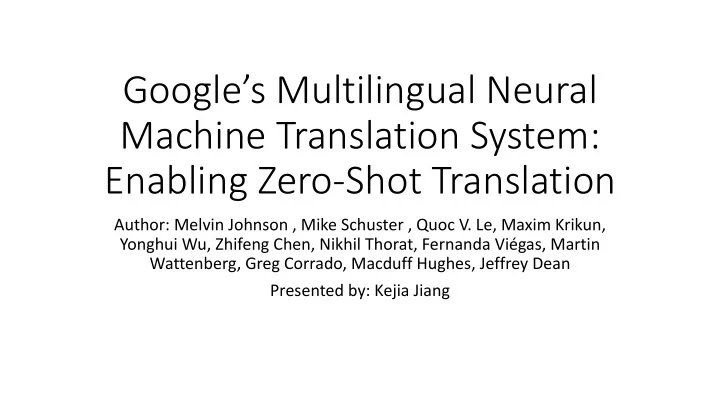

Google’s Multilingual Neural Machine Translation System: Enabling Zero-Shot Translation Author: Melvin Johnson , Mike Schuster , Quoc V. Le, Maxim Krikun, Yonghui Wu, Zhifeng Chen, Nikhil Thorat, Fernanda Viégas, Martin Wattenberg, Greg Corrado, Macduff Hughes, Jeffrey Dean Presented by: Kejia Jiang
Introduction • A single Neural Machine Translation (NMT) model to translate between multiple languages. • Simplicity Requires no change to the traditional NMT model architecture. • Low-resource language improvements Language pairs with little available data and language pairs with abundant data are mixed together. • Zero-shot translation Translates between arbitrary languages, including unseen language pairs during the training process.
Related work • The multilingual model architecture is identical to Google’s Neural Machine Translation (GNMT) system (Wu et al., 2016) Google’s Neural Machine Translation System: Bridging the Gap between Human and Machine Translation (Wu et al., 2016) • GNMT model consists of a deep LSTM network with 8 encoder and 8 decoder layers using residual connections and attention connections. • Accurate • Fast • Robustness to rare words
GNMT Deep Stacked LSTMs
GNMT attention module • Context a i for the current time step is computed according to the following formulas: • Here the AttentionFunction is a feed forward network with one hidden layer.
GNMT Residual Connections
GNMT Residual Connections • With residual connections between LSTM i and LSTM i+1 , the above equations become:
GNMT Wordpiece Model • To address the translation of out-of-vocabulary (OOV) words, GNMT applys sub-word units to do segmentation. • Example: Word: Jet makers feud over seat width with big orders at stake . Wordpieces: _J et _makers _fe ud _over _seat _width _with _big _orders _at _stake. • This method provides a good balance between the flexibility of “character”-delimited models and the efficiency of “word”-delimited models.
GNMT with zero-shot translation • Based on the GNMT, the system adds an artificial token at the beginning of the input sentence to indicate the target language the model should translate to. • Exmaple: En→Es Instead of : How are you? -> ¿Cómo estás? put <2es> at the beginning: <2es> How are you? -> ¿Cómo estás?
Zero-shot translation • The system use implicit bridging to deal with the problem. No explicit parallel training data has been seen. • Although the source and target languages should be seen individually during the training at some point.
To improve zero-shot translation quality • Incrementally training the multilingual model on the additional parallel data for the zero-shot directions. • Zero-shot: En↔{Be,Ru,Uk} • From-scratch: En↔{Be,Ru,Uk} + Ru↔{Be, Uk} • Incremental: Zero-shot + From-scratch
Mixed language • Can a multilingual model successfully handle multi-language input (code-switching) in the middle of a sentence? • Yes! Because the individual characters/wordpieces are present in the shared vocabulary.
Mixed language (2) • What happens when a multilingual model is triggered with a linear mix of two target language tokens? • Example: Using a multilingual En→{Ja, Ko} model, feed a linear combination (1−w)<2ja>+w<2ko> of the embedding vectors for “<2ja>” and “<2ko>”, 0 <= w <= 1. Result : with w = 0.5, the model switches languages mid- sentence.
Conclusion • Use a single model where all parameters are shared, which improves the translation quality of low resource languages in the mix. • Zero-shot translation without explicit bridging is possible. • To improve the zero-shot translation quality: Incrementally training the multilingual model on the additional parallel data for the zero-shot directions. • Mix languages on the source or target side can yield interesting but reliable translation results.
Thank you!
Recommend
More recommend